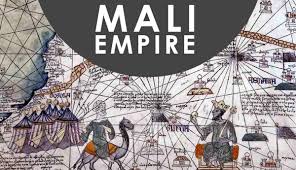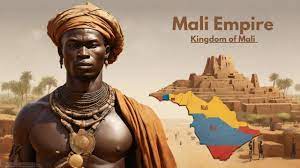The Mali Empire was a prominent and influential West African empire known for its wealth, cultural achievements, and significant contributions to trade and education. Here are key points about its history, culture, and significance:
Origins and Expansion
- Foundation: The Mali Empire was founded by Sundiata Keita, also known as the “Lion King,” who unified various tribes and established the empire after the Battle of Kirina in 1235.
- Expansion: Under successive rulers, the empire expanded significantly, reaching its height during the 14th century, covering modern-day Mali, Senegal, Gambia, Guinea, Niger, Nigeria, Chad, and Mauritania.

Key Figures
- Sundiata Keita: Founder of the Mali Empire, he established a centralized administration and laid the foundation for the empire’s prosperity.
- Mansa Musa: The most famous ruler of Mali, known for his pilgrimage to Mecca in 1324, which showcased the empire’s immense wealth and brought international attention. His reign saw the empire reach its peak in terms of territorial expansion and economic prosperity.
- Mansa Suleyman: Known for maintaining the empire’s stability and continuing its legacy of wealth and cultural achievements.
Administration and Society
- Government: The empire was governed by a centralized administration with the mansa (emperor) at its head, supported by provincial governors and local chiefs.
- Economy: The economy was based on agriculture, trade, and the control of gold mines. The Mali Empire was one of the world’s largest gold producers.
- Trade: The empire was a major hub in trans-Saharan trade networks, dealing in gold, salt, copper, ivory, and slaves. Key trading cities included Timbuktu, Gao, and Djenné.
Culture and Achievements
- Islam: Islam was a significant influence in the Mali Empire, especially among the ruling class. It facilitated trade and educational exchanges with North Africa and the Middle East.
- Education: Timbuktu became a renowned center of learning, home to prestigious universities such as the University of Sankore and numerous madrasas (Islamic schools). Scholars from across the Islamic world traveled to study in Mali.
- Architecture: The Mali Empire is known for its distinctive Sudano-Sahelian architecture, exemplified by the Great Mosque of Djenné and the Sankore Mosque.
- Literature and Scholarship: Manuscripts from this period cover various subjects, including theology, law, science, and history, reflecting the intellectual vitality of the empire.
Decline and Fall
- Internal Strife: The empire began to decline in the late 14th century due to internal conflicts and succession disputes.
- External Pressure: Attacks by the Mossi people and the rising power of the Songhai Empire further weakened Mali’s control over its territories.
- Loss of Territory: By the 15th century, the empire had lost many of its important provinces and cities, leading to a significant reduction in its power and influence.
- End of the Empire: The empire effectively ended in the early 17th century, with the rise of the Songhai Empire and internal fragmentation.
Legacy
- Cultural Influence: The Mali Empire left a lasting cultural legacy in West Africa, influencing the region’s language, religion, art, and architecture.
- Educational Impact: The emphasis on education and scholarship in cities like Timbuktu had a long-term impact on Islamic learning in West Africa.
- Economic Contributions: The empire’s role in trans-Saharan trade contributed to the economic development of the region and established lasting trade connections.
The Mali Empire is remembered for its wealth, cultural achievements, and significant contributions to the history and development of West Africa.
4o
